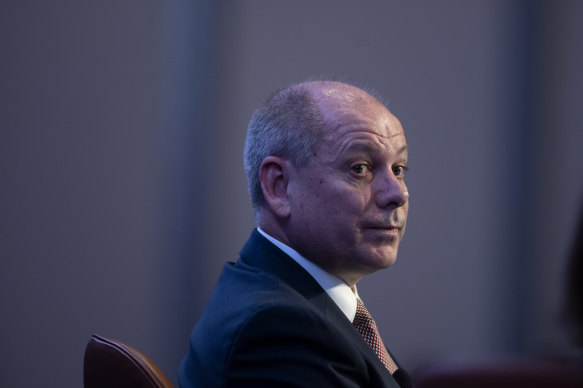This was published 11 months ago
Westpac quarterly profits rise to $1.8 billion, CEO flags cost-of-living pressures
Westpac’s profits climbed to $1.8 billion in the June quarter, chief executive Peter King revealed, as he noted many businesses were seeing lower demand for their goods as the cost-of-living pressure bites.
While the bank’s revenue was flat and expenses grew 2 per cent, Westpac reported an unaudited net profit of $1.8 billion in the June quarter – a 6 per cent rise on the first half – on the back of lower charges for bad debts.

“The cost of living and high-interest rates remain a challenge for some customers while many businesses are facing cost pressures and experiencing lower demand.“: Westpac CEO Peter King.Credit: Louise Kennerley
Net interest margin (NIM) – a core measure of profitability – rose 3 basis points to 1.9 per cent, while core NIM lifted 2 basis points to 1.8 per cent.
“We continue to prioritise financial strength with capital, funding and liquidity well above regulatory minimums,” King said.
“The cost of living and high-interest rates remain a challenge for some customers while many businesses are facing cost pressures and experiencing lower demand. We encourage customers to call us if they need help.”
Mortgage holders who were 30 days behind their repayments rose to 1.9 per cent of the bank’s home loan portfolio, while those 90 days behind increased to 1.1 per cent. Westpac said 1.4 per cent of its lending book was delinquent, or on a watch list, up 26 basis points in a year.
As well as the rise in mortgage arrears, Westpac said it had downgraded a small number of business customers in the wholesale and retail sectors, and in agriculture, forestry and fishing.
Customer deposits and loans grew 3 per cent ($15.4 billion) and 8 per cent ($14.7 billion), respectively.
E&P analyst Azib Khan said Westpac’s flat revenue had been offset by a lower-than-expected credit impairment charge and softer expenses growth.
“The pleasing element is that [third quarter] NIM is better than expected, staying stable at the [first half],” Khan said. “The element of increasing concern across the sector is asset quality.”
The update from Westpac follows results from Commonwealth Bank and National Australia Bank that have shown the country’s biggest banks are generally experiencing lower bad debts than analysts had expected, despite the weakening economy.
Barrenjoey analyst Jon Mott said the widening in Westpac’s margin was the highlight of the result, while also noting the bank’s profit was helped by a very low charge for soured loans.
Westpac’s common equity tier 1 capital ratio was 12 per cent, above the target operating range, and Mott said he expected the bank would return some of its excess capital to shareholders through special dividends at the full-year results later this year.
While Mott has an “overweight” rating on Westpac, he said he remained very cautious on the wider banking sector, where he said “valuation stretch is now extreme”.
UBS analyst John Storey also said Westpac remained well-placed to return further capital to shareholders at the end of the year. Storey said Westpac’s quarterly result was similar to Commonwealth Bank’s result last week, which also showed a better net interest margin and lower bad debts than the market had expected.
Westpac shares gained 2.5 per cent to $30.40, leading shares in the big four higher.
With Clancy Yeates
The Business Briefing newsletter delivers major stories, exclusive coverage and expert opinion. Sign up to get it every weekday morning.